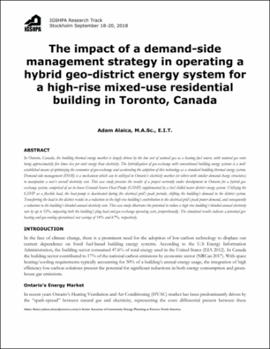| dc.contributor.author | Alaica, Adam | |
| dc.contributor.other | IGSHPA Research Track (2018) | |
| dc.date.accessioned | 2018-08-28T17:58:54Z | |
| dc.date.available | 2018-08-28T17:58:54Z | |
| dc.date.issued | 2018 | |
| dc.identifier | oksd_ighspa_2018_alaica | |
| dc.identifier.uri | https://hdl.handle.net/11244/301569 | |
| dc.description.abstract | In Ontario, Canada, the building thermal energy market is largely driven by the low cost of natural gas as a heating fuel source, with natural gas rates being approximately five times less per unit energy than electricity. The hybridization of geo-exchange with conventional building energy systems is a well-established means of optimizing the economics of geo-exchange and accelerating the adoption of this technology as a standard building thermal energy system. Demand-side management (DSM) is a mechanism which can be utilized in Ontario's electricity market (or others with similar demand charge structures) to manipulate a user's overall electricity cost. This case study presents the results of a project currently under development in Ontario for a hybrid geo-exchange system, comprised of an in-house Ground-Source Heat-Pump (GSHP) supplemented by a hot/chilled water district energy system. Utilizing the GSHP as a flexible load, the heat-pump is deactivated during the electrical grid's peak periods, shifting the building's demand to the district system. Transferring the load to the district results in a reduction in the high-rise building's contribution to the electrical grid's peak power demand, and consequently a reduction in the building's blended annual electricity rate. This case study illustrates the potential to reduce a high-rise building's blended annual electricity rate by up to 52%, impacting both the building's plug load and geo-exchange operating costs, proportionally. The simulated results indicate a potential geo-heating and geo-cooling operational cost savings of 14% and 67%, respectively. | |
| dc.format | application/pdf | |
| dc.language | en_US | |
| dc.publisher | International Ground Source Heat Pump Association | |
| dc.rights | In the Oklahoma State University Library's institutional repository this paper is made available through the open access principles and the terms of agreement/consent between the author(s) and the publisher. The permission policy on the use, reproduction or distribution of the article falls under fair use for educational, scholarship, and research purposes. Contact Digital Resources and Discovery Services at lib-dls@okstate.edu or 405-744-9161 for further information. | |
| dc.title | Impact of a demand-side management strategy in operating a hybrid geo-district energy system for a high-rise mixed-use residential building in Toronto, Canada | |
| osu.filename | oksd_ighspa_2018_alaica.pdf | |
| dc.identifier.doi | 10.22488/okstate.18.000004 | |
| dc.type.genre | Conference proceedings | |
| dc.type.material | Text | |
